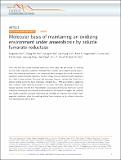| dc.contributor.author | Kim, Sunghwan | |
| dc.contributor.author | Kim, Chang Min | |
| dc.contributor.author | Son, Young-Jin | |
| dc.contributor.author | Choi, Jae Young | |
| dc.contributor.author | Siegenthaler, Rahel K. | |
| dc.contributor.author | Lee, Younho | |
| dc.contributor.author | Jang, Tae-Ho | |
| dc.contributor.author | Song, Jaeyoung | |
| dc.contributor.author | Kang, Hara | |
| dc.contributor.author | Kaiser, Chris A. | |
| dc.contributor.author | Park, Hyun Ho | |
| dc.date.accessioned | 2020-05-08T15:59:46Z | |
| dc.date.available | 2020-05-08T15:59:46Z | |
| dc.date.issued | 2018-11 | |
| dc.date.submitted | 2018-03 | |
| dc.identifier.issn | 2041-1723 | |
| dc.identifier.uri | https://hdl.handle.net/1721.1/125140 | |
| dc.description.abstract | Osm1 and Frd1 are soluble fumarate reductases from yeast that are critical for allowing survival under anaerobic conditions. Although they maintain redox balance during anaerobiosis, the underlying mechanism is not understood. Here, we report the crystal structure of a eukaryotic soluble fumarate reductase, which is unique among soluble fumarate reductases as it lacks a heme domain. Structural and enzymatic analyses indicate that Osm1 has a specific binding pocket for flavin molecules, including FAD, FMN, and riboflavin, catalyzing their oxidation while reducing fumarate to succinate. Moreover, ER-resident Osm1 can transfer electrons from the Ero1 FAD cofactor to fumarate either by free FAD or by a direct interaction, allowing de novo disulfide bond formation in the absence of oxygen. We conclude that soluble eukaryotic fumarate reductases can maintain an oxidizing environment under anaerobic conditions, either by oxidizing cellular flavin cofactors or by a direct interaction with flavoenzymes such as Ero1. Keywords: Enzyme mechanisms; Oxidoreductases; X-ray crystallography | en_US |
| dc.description.sponsorship | National Research Foundation of Korea. Basic Science Research Program (Grant NRF-2017M3A9D8062960) | en_US |
| dc.description.sponsorship | National Research Foundation of Korea. Basic Science Research Program (Grant NRF-2014R1A1A1003451) | en_US |
| dc.description.sponsorship | National Research Foundation of Korea. Basic Science Research Program (Grant NRF-2018R1A2B2003635) | en_US |
| dc.description.sponsorship | Korea Healthcare Technology R&D Project, Ministry of Health & Welfare, Republic of Korea (HI17C0155) | en_US |
| dc.language.iso | en | |
| dc.publisher | Springer Science and Business Media LLC | en_US |
| dc.relation.isversionof | http://dx.doi.org/10.1038/s41467-018-07285-9 | en_US |
| dc.rights | Creative Commons Attribution 4.0 International license | en_US |
| dc.rights.uri | https://creativecommons.org/licenses/by/4.0/ | en_US |
| dc.source | Nature | en_US |
| dc.title | Molecular basis of maintaining an oxidizing environment under anaerobiosis by soluble fumarate reductase | en_US |
| dc.type | Article | en_US |
| dc.identifier.citation | Kim, Sunghwan et al. "Molecular basis of maintaining an oxidizing environment under anaerobiosis by soluble fumarate reductase." Nature Communications 9 (November 2018): 4867 © 2018, The Author(s). | en_US |
| dc.contributor.department | Massachusetts Institute of Technology. Department of Biology | en_US |
| dc.relation.journal | Nature Communications | en_US |
| dc.eprint.version | Final published version | en_US |
| dc.type.uri | http://purl.org/eprint/type/JournalArticle | en_US |
| eprint.status | http://purl.org/eprint/status/PeerReviewed | en_US |
| dc.date.updated | 2019-12-12T14:20:46Z | |
| dspace.date.submission | 2019-12-12T14:20:48Z | |
| mit.journal.volume | 9 | en_US |
| mit.journal.issue | 1 | en_US |
| mit.metadata.status | Complete | |
